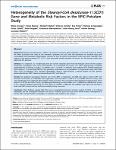Heterogeneity of the Stearoyl-CoA desaturase-1 (SCD1) Gene and Metabolic Risk Factors in the EPIC-Potsdam Study
Arregui, Maria
Buijsse, Brian
Stefan, Norbert
Corella, Dolores
Fisher, Eva
Giuseppe, Romina di
Coltell, Oscar
Knüppel, Sven
Aleksandrova, Krasimira
Joost, Hans-Georg
Boeing, Heiner
Weikert, Cornelia
Background: Stearoyl-CoA desaturase-1 (SCD1) is an enzyme involved in lipid metabolism. In mice and humans its activity has been associated with traits of the metabolic syndrome, but also with the prevention of saturated fatty acids accumulation and subsequent inflammation, whereas for liver fat content inconsistent results have been reported. Thus, variants of the gene encoding SCD1 (SCD1) could potentially modify metabolic risk factors, but few human studies have addressed this question. Methods: In a sample of 2157 middle-aged men and women randomly drawn from the Potsdam cohort of the European Prospective Investigation into Cancer and Nutrition, we investigated the impact of 7 SCD1 tagging-single nucleotide polymorphisms (rs1502593, rs522951, rs11190480, rs3071, rs3793767, rs10883463 and rs508384) and 5 inferred haplotypes with frequency >5% describing 90.9% of the genotype combinations in our population, on triglycerides, body mass index (BMI), waist circumference (WC), glycated haemoglobin (HbA1c), high-sensitivity C-reactive protein (hs-CRP), gamma-glutamyltransferase (GGT), alanine aminotransferase (ALT) and fetuin-A. Results: No significant associations between any of the SNPs or haplotypes and BMI, WC, fetuin-A and hs-CRP were observed. Associations of rs10883463 with triglycerides, GGT and HbA1c as well as of rs11190480 with ALT activity, were weak and became non-significant after multiple-testing correction. Also associations of the haplotype harbouring the minor allele of rs1502593 with HbA1c levels, the haplotype harbouring the minor alleles of rs11190480 and rs508384 with activity of ALT, and the haplotype harbouring the minor alleles of rs522951, rs10883463 and rs508384 with triglyceride and HbA1C levels and GGT activities did not withstand multiple-testing correction. Conclusion: These findings suggest that there are no associations between common variants of SCD1 or its inferred haplotypes and the investigated metabolic risk factors. However, given the results from animal models, heterogeneity of human SCD1 warrants further investigation, in particular with regard to rare variants.
No license information
Related Items
Show related Items with similar Title, Author, Creator or Subject.
-
2007-05-25ZeitschriftenartikelFepA- and TonB-dependent bacteriophage H8: receptor binding and genomic sequence. Rabsch, Wolfgang; Ma, Li; Wiley, Graham; Najar, Fares Z.; Kaserer, Wallace; Schuerch, Daniel W.; Klebba, Joseph E.; Roe, Bruce A.; Gomez, Jenny A. Laverde; Schallmey, Marcus; Newton, Salete M. C.; Klebba, Phillip E.H8 is derived from a collection of Salmonella enterica serotype Enteritidis bacteriophage. Its morphology and genomic structure closely resemble those of bacteriophage T5 in the family Siphoviridae. H8 infected S. enterica ...
-
2005-06-20ZeitschriftenartikelViral promoters can initiate expression of toxin genes introduced into Escherichia coli Lewin, Astrid; Mayer, Martin; Chusainow, Janet; Jacob, Daniela; Appel, BerndBackground: The expression of recombinant proteins in eukaryotic cells requires the fusion of the coding region to a promoter functional in the eukaryotic cell line. Viral promoters are very often used for this purpose. ...
-
2013-08-08ZeitschriftenartikelCytomegalovirus Downregulates IRE1 to Repress the Unfolded Protein Response Stahl, Sebastian; Burkhart, Julia M.; Hinte, Florian; Tirosh, Boaz; Mohr, Hermine; Zahedi, René P.; Sickmann, Albert; Ruzsics, Zsolt; Budt, Matthias; Brune, WolframDuring viral infection, a massive demand for viral glycoproteins can overwhelm the capacity of the protein folding and quality control machinery, leading to an accumulation of unfolded proteins in the endoplasmic reticulum ...

